Spring 2020 MG 4343 Operation Management Project: Hospitality Sector
VerifiedAdded on 2022/09/07
|14
|2751
|17
Project
AI Summary
This project analyzes the hospitality sector as a business service system, examining its operational strategies and customer service delivery. It explores strategic priorities, including mission, vision, and values, and analyzes a customer service flowchart. The project identifies operational challenges such as technological changes, political instability, and seasonality, and discusses existing and needed defect prevention and correction mechanisms. It positions the service process on a service design matrix, evaluating its advantages and disadvantages, and outlines the organization of service delivery. The project emphasizes the importance of effective management, recommending clear service matrices, regular staff training, and minimal supervision to foster employee self-esteem and efficient service delivery. The analysis concludes that operational choices made by operations managers have direct implications and need to be handled effectively.
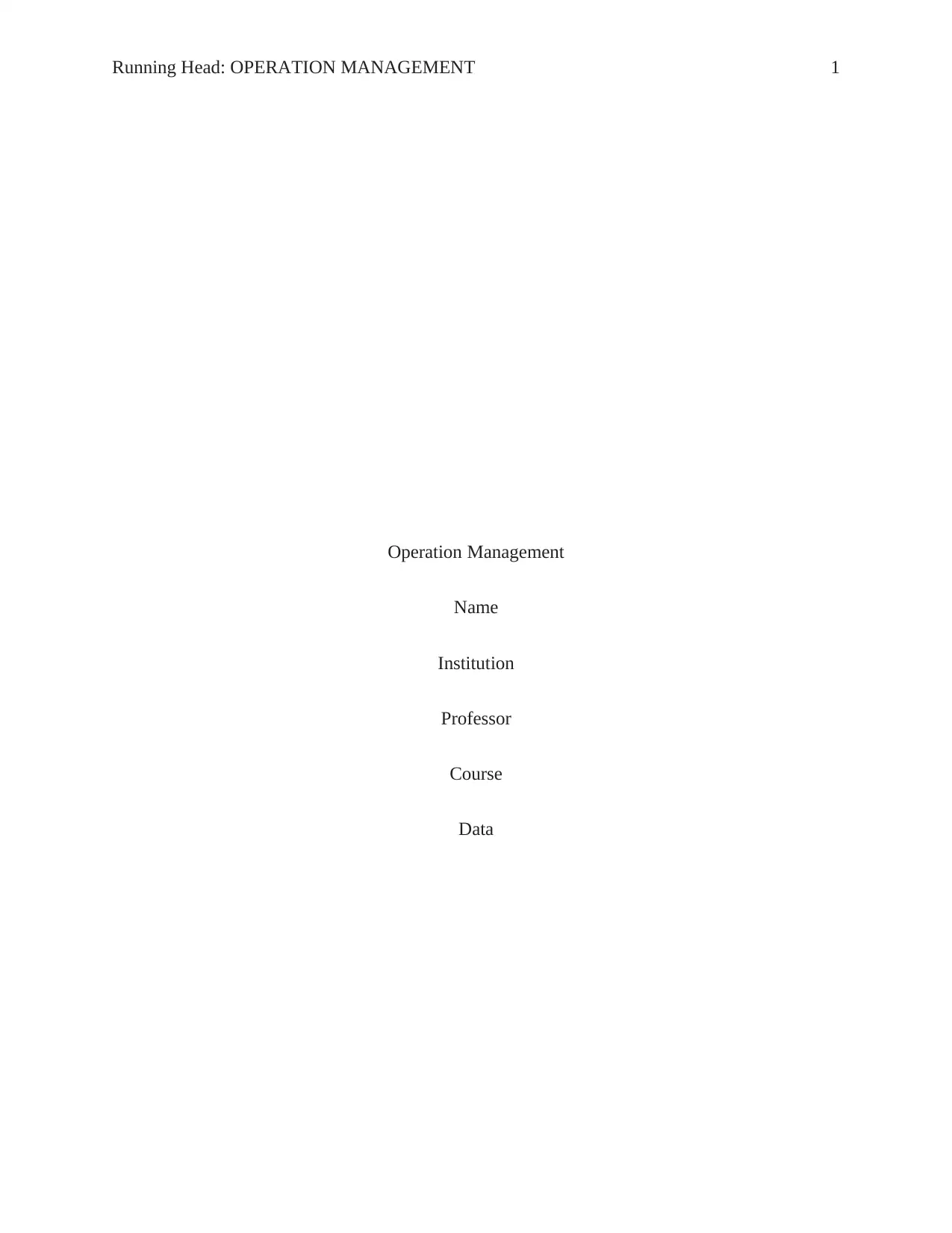
Running Head: OPERATION MANAGEMENT 1
Operation Management
Name
Institution
Professor
Course
Data
Operation Management
Name
Institution
Professor
Course
Data
Paraphrase This Document
Need a fresh take? Get an instant paraphrase of this document with our AI Paraphraser
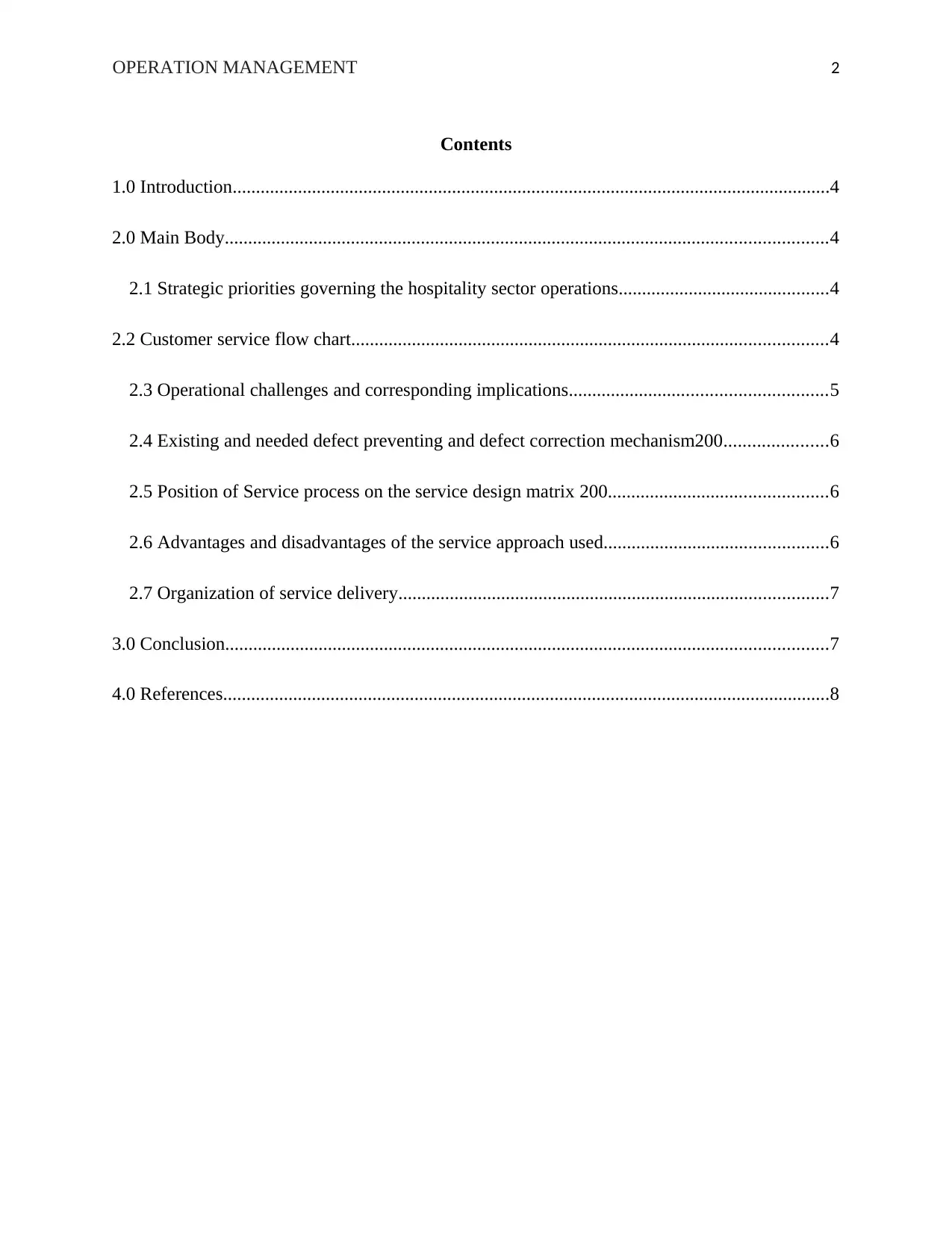
OPERATION MANAGEMENT 2
Contents
1.0 Introduction................................................................................................................................4
2.0 Main Body.................................................................................................................................4
2.1 Strategic priorities governing the hospitality sector operations.............................................4
2.2 Customer service flow chart......................................................................................................4
2.3 Operational challenges and corresponding implications.......................................................5
2.4 Existing and needed defect preventing and defect correction mechanism200......................6
2.5 Position of Service process on the service design matrix 200...............................................6
2.6 Advantages and disadvantages of the service approach used................................................6
2.7 Organization of service delivery............................................................................................7
3.0 Conclusion.................................................................................................................................7
4.0 References..................................................................................................................................8
Contents
1.0 Introduction................................................................................................................................4
2.0 Main Body.................................................................................................................................4
2.1 Strategic priorities governing the hospitality sector operations.............................................4
2.2 Customer service flow chart......................................................................................................4
2.3 Operational challenges and corresponding implications.......................................................5
2.4 Existing and needed defect preventing and defect correction mechanism200......................6
2.5 Position of Service process on the service design matrix 200...............................................6
2.6 Advantages and disadvantages of the service approach used................................................6
2.7 Organization of service delivery............................................................................................7
3.0 Conclusion.................................................................................................................................7
4.0 References..................................................................................................................................8
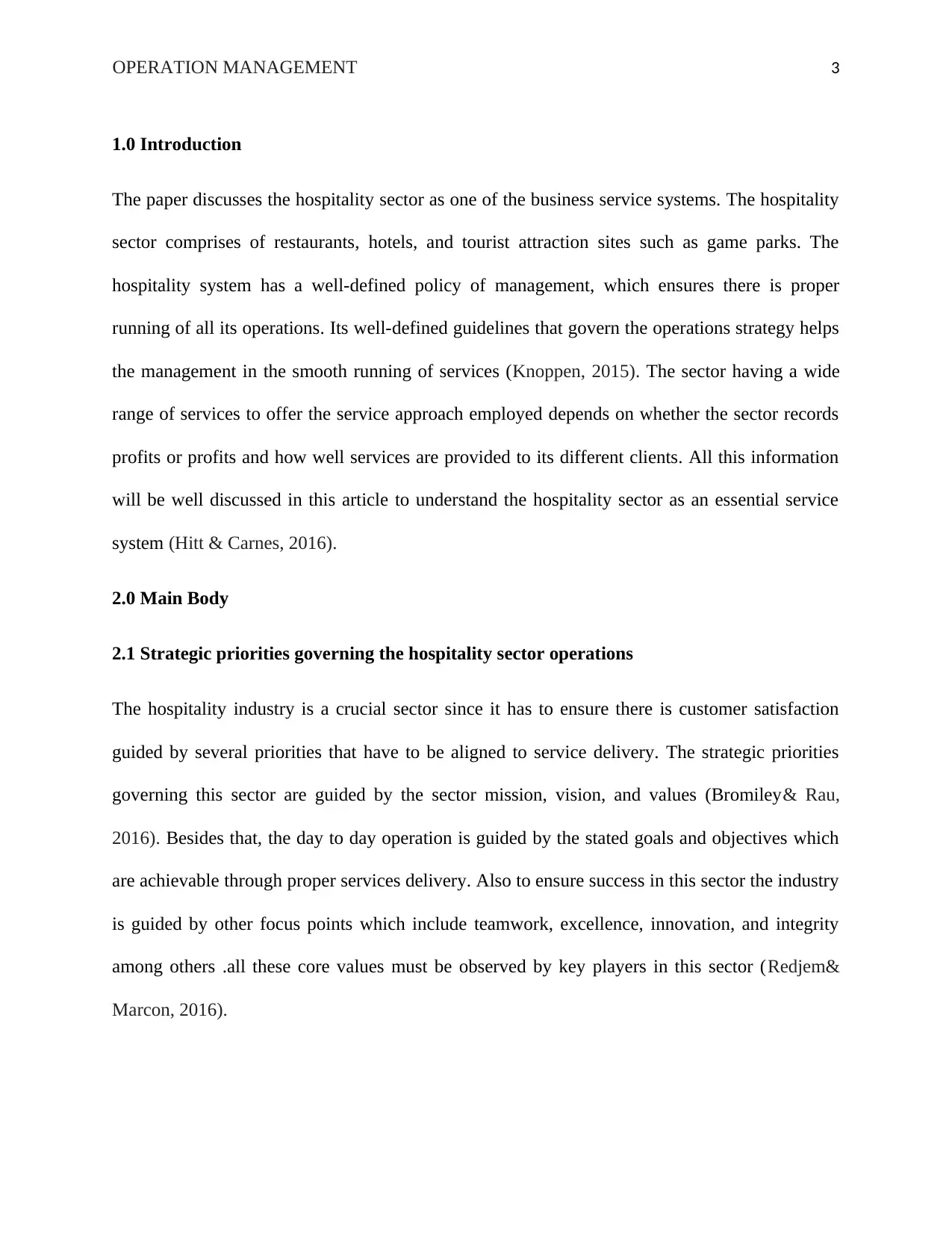
OPERATION MANAGEMENT 3
1.0 Introduction
The paper discusses the hospitality sector as one of the business service systems. The hospitality
sector comprises of restaurants, hotels, and tourist attraction sites such as game parks. The
hospitality system has a well-defined policy of management, which ensures there is proper
running of all its operations. Its well-defined guidelines that govern the operations strategy helps
the management in the smooth running of services (Knoppen, 2015). The sector having a wide
range of services to offer the service approach employed depends on whether the sector records
profits or profits and how well services are provided to its different clients. All this information
will be well discussed in this article to understand the hospitality sector as an essential service
system (Hitt & Carnes, 2016).
2.0 Main Body
2.1 Strategic priorities governing the hospitality sector operations
The hospitality industry is a crucial sector since it has to ensure there is customer satisfaction
guided by several priorities that have to be aligned to service delivery. The strategic priorities
governing this sector are guided by the sector mission, vision, and values (Bromiley& Rau,
2016). Besides that, the day to day operation is guided by the stated goals and objectives which
are achievable through proper services delivery. Also to ensure success in this sector the industry
is guided by other focus points which include teamwork, excellence, innovation, and integrity
among others .all these core values must be observed by key players in this sector (Redjem&
Marcon, 2016).
1.0 Introduction
The paper discusses the hospitality sector as one of the business service systems. The hospitality
sector comprises of restaurants, hotels, and tourist attraction sites such as game parks. The
hospitality system has a well-defined policy of management, which ensures there is proper
running of all its operations. Its well-defined guidelines that govern the operations strategy helps
the management in the smooth running of services (Knoppen, 2015). The sector having a wide
range of services to offer the service approach employed depends on whether the sector records
profits or profits and how well services are provided to its different clients. All this information
will be well discussed in this article to understand the hospitality sector as an essential service
system (Hitt & Carnes, 2016).
2.0 Main Body
2.1 Strategic priorities governing the hospitality sector operations
The hospitality industry is a crucial sector since it has to ensure there is customer satisfaction
guided by several priorities that have to be aligned to service delivery. The strategic priorities
governing this sector are guided by the sector mission, vision, and values (Bromiley& Rau,
2016). Besides that, the day to day operation is guided by the stated goals and objectives which
are achievable through proper services delivery. Also to ensure success in this sector the industry
is guided by other focus points which include teamwork, excellence, innovation, and integrity
among others .all these core values must be observed by key players in this sector (Redjem&
Marcon, 2016).
⊘ This is a preview!⊘
Do you want full access?
Subscribe today to unlock all pages.

Trusted by 1+ million students worldwide
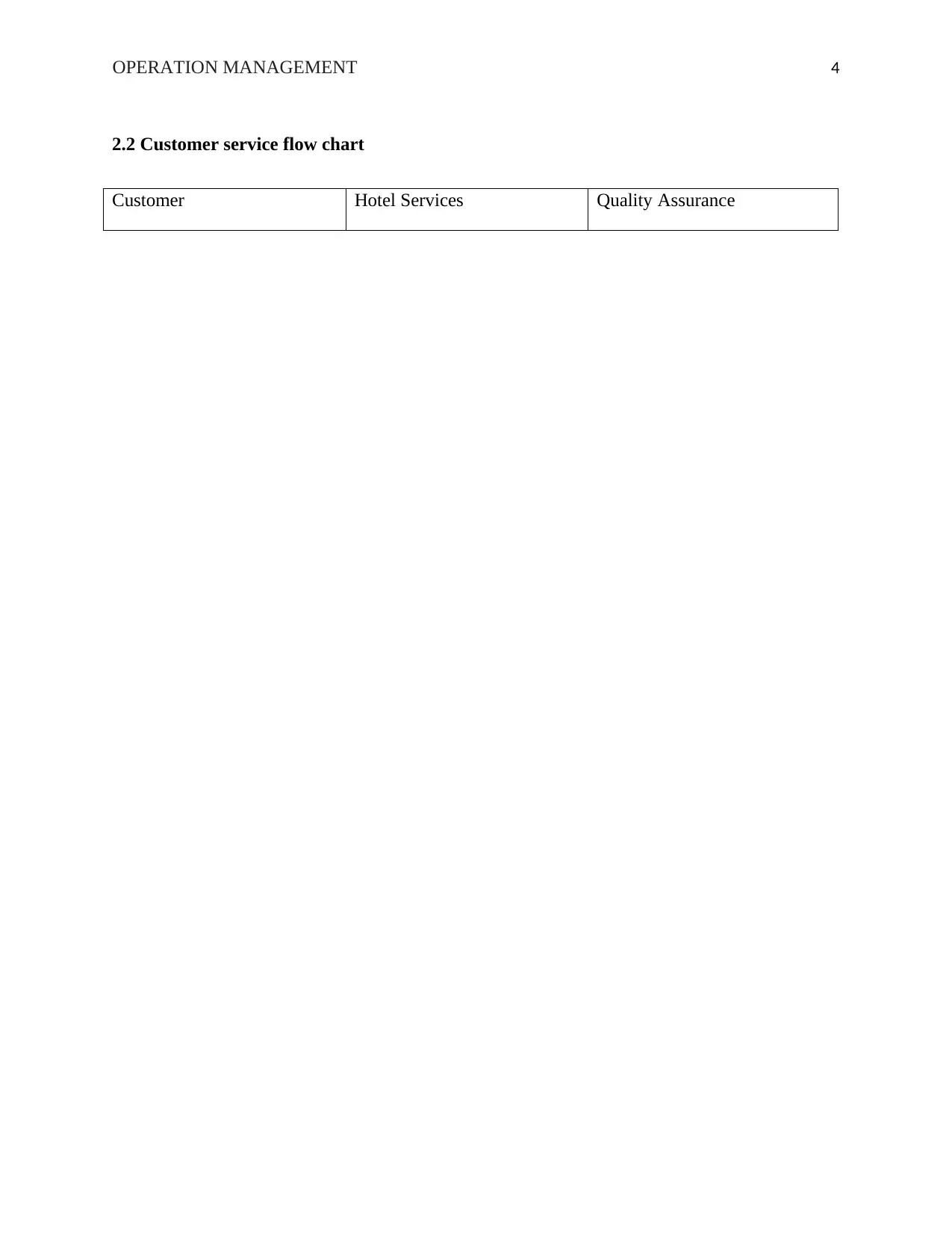
OPERATION MANAGEMENT 4
2.2 Customer service flow chart
Customer Hotel Services Quality Assurance
2.2 Customer service flow chart
Customer Hotel Services Quality Assurance
Paraphrase This Document
Need a fresh take? Get an instant paraphrase of this document with our AI Paraphraser
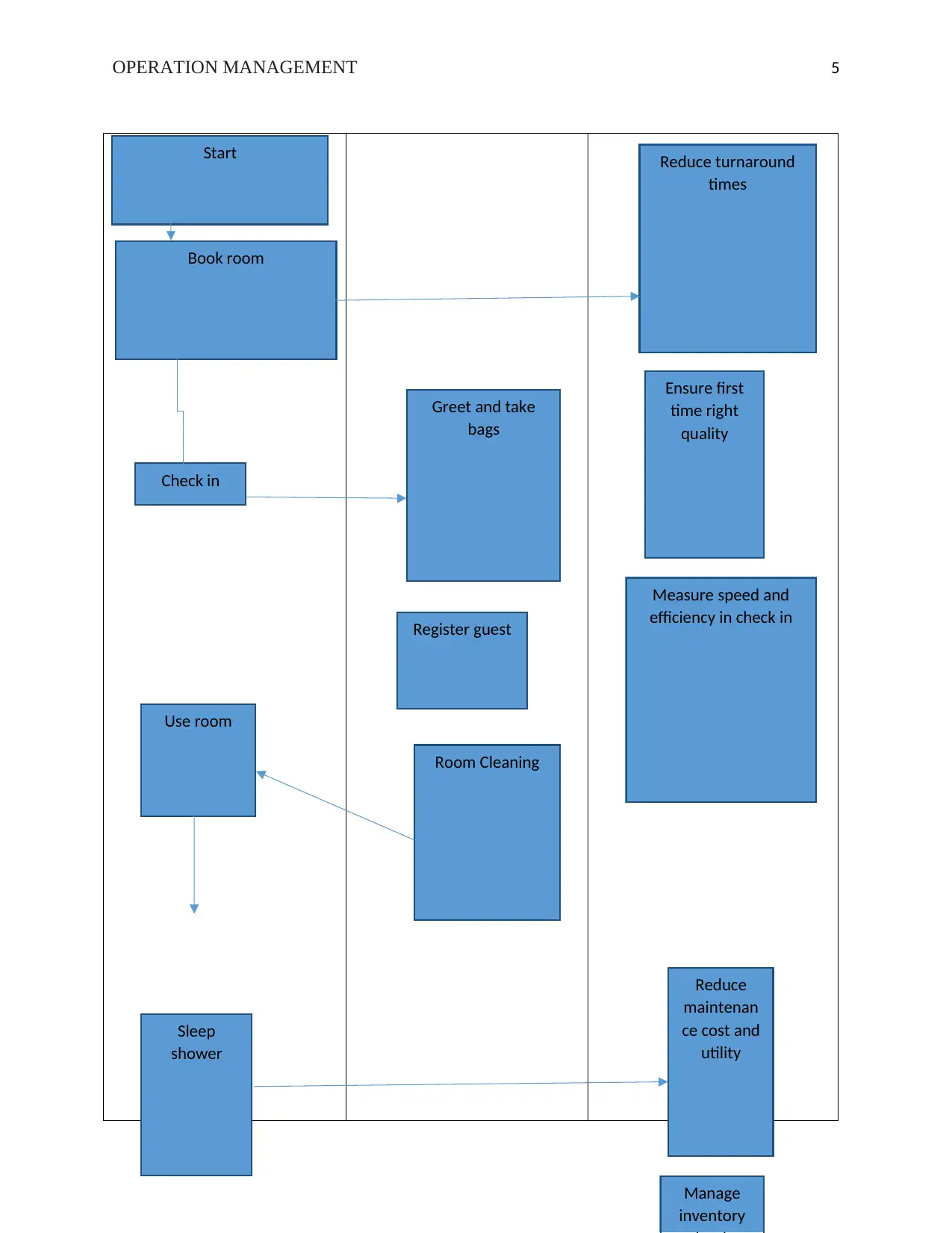
OPERATION MANAGEMENT 5
Book room
Start
Check in
Use room
Sleep
shower
Greet and take
bags
Register guest
Room Cleaning
Reduce turnaround
times
Ensure first
time right
quality
Measure speed and
efficiency in check in
Reduce
maintenan
ce cost and
utility
Manage
inventory
Book room
Start
Check in
Use room
Sleep
shower
Greet and take
bags
Register guest
Room Cleaning
Reduce turnaround
times
Ensure first
time right
quality
Measure speed and
efficiency in check in
Reduce
maintenan
ce cost and
utility
Manage
inventory
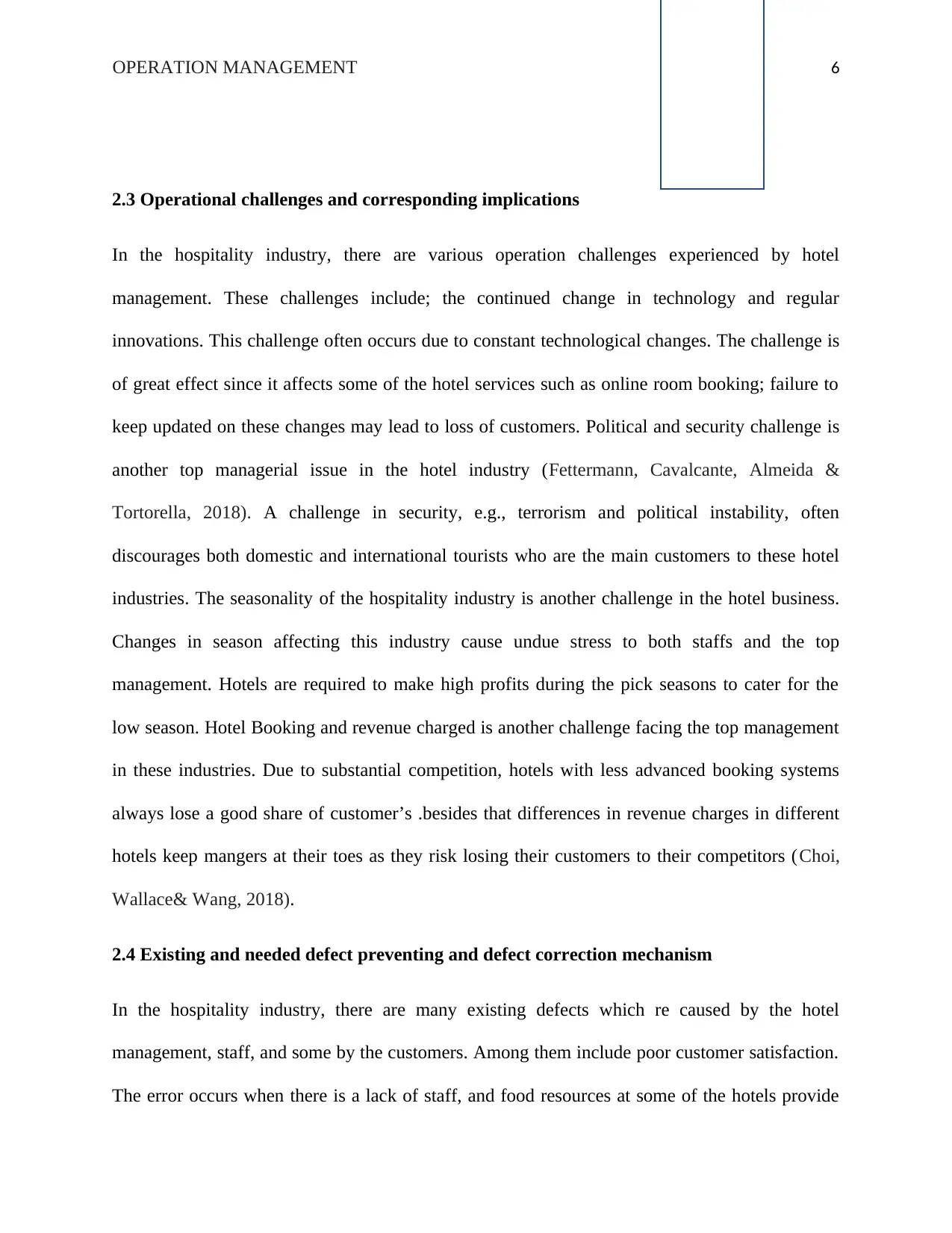
OPERATION MANAGEMENT 6
2.3 Operational challenges and corresponding implications
In the hospitality industry, there are various operation challenges experienced by hotel
management. These challenges include; the continued change in technology and regular
innovations. This challenge often occurs due to constant technological changes. The challenge is
of great effect since it affects some of the hotel services such as online room booking; failure to
keep updated on these changes may lead to loss of customers. Political and security challenge is
another top managerial issue in the hotel industry (Fettermann, Cavalcante, Almeida &
Tortorella, 2018). A challenge in security, e.g., terrorism and political instability, often
discourages both domestic and international tourists who are the main customers to these hotel
industries. The seasonality of the hospitality industry is another challenge in the hotel business.
Changes in season affecting this industry cause undue stress to both staffs and the top
management. Hotels are required to make high profits during the pick seasons to cater for the
low season. Hotel Booking and revenue charged is another challenge facing the top management
in these industries. Due to substantial competition, hotels with less advanced booking systems
always lose a good share of customer’s .besides that differences in revenue charges in different
hotels keep mangers at their toes as they risk losing their customers to their competitors (Choi,
Wallace& Wang, 2018).
2.4 Existing and needed defect preventing and defect correction mechanism
In the hospitality industry, there are many existing defects which re caused by the hotel
management, staff, and some by the customers. Among them include poor customer satisfaction.
The error occurs when there is a lack of staff, and food resources at some of the hotels provide
2.3 Operational challenges and corresponding implications
In the hospitality industry, there are various operation challenges experienced by hotel
management. These challenges include; the continued change in technology and regular
innovations. This challenge often occurs due to constant technological changes. The challenge is
of great effect since it affects some of the hotel services such as online room booking; failure to
keep updated on these changes may lead to loss of customers. Political and security challenge is
another top managerial issue in the hotel industry (Fettermann, Cavalcante, Almeida &
Tortorella, 2018). A challenge in security, e.g., terrorism and political instability, often
discourages both domestic and international tourists who are the main customers to these hotel
industries. The seasonality of the hospitality industry is another challenge in the hotel business.
Changes in season affecting this industry cause undue stress to both staffs and the top
management. Hotels are required to make high profits during the pick seasons to cater for the
low season. Hotel Booking and revenue charged is another challenge facing the top management
in these industries. Due to substantial competition, hotels with less advanced booking systems
always lose a good share of customer’s .besides that differences in revenue charges in different
hotels keep mangers at their toes as they risk losing their customers to their competitors (Choi,
Wallace& Wang, 2018).
2.4 Existing and needed defect preventing and defect correction mechanism
In the hospitality industry, there are many existing defects which re caused by the hotel
management, staff, and some by the customers. Among them include poor customer satisfaction.
The error occurs when there is a lack of staff, and food resources at some of the hotels provide
⊘ This is a preview!⊘
Do you want full access?
Subscribe today to unlock all pages.

Trusted by 1+ million students worldwide
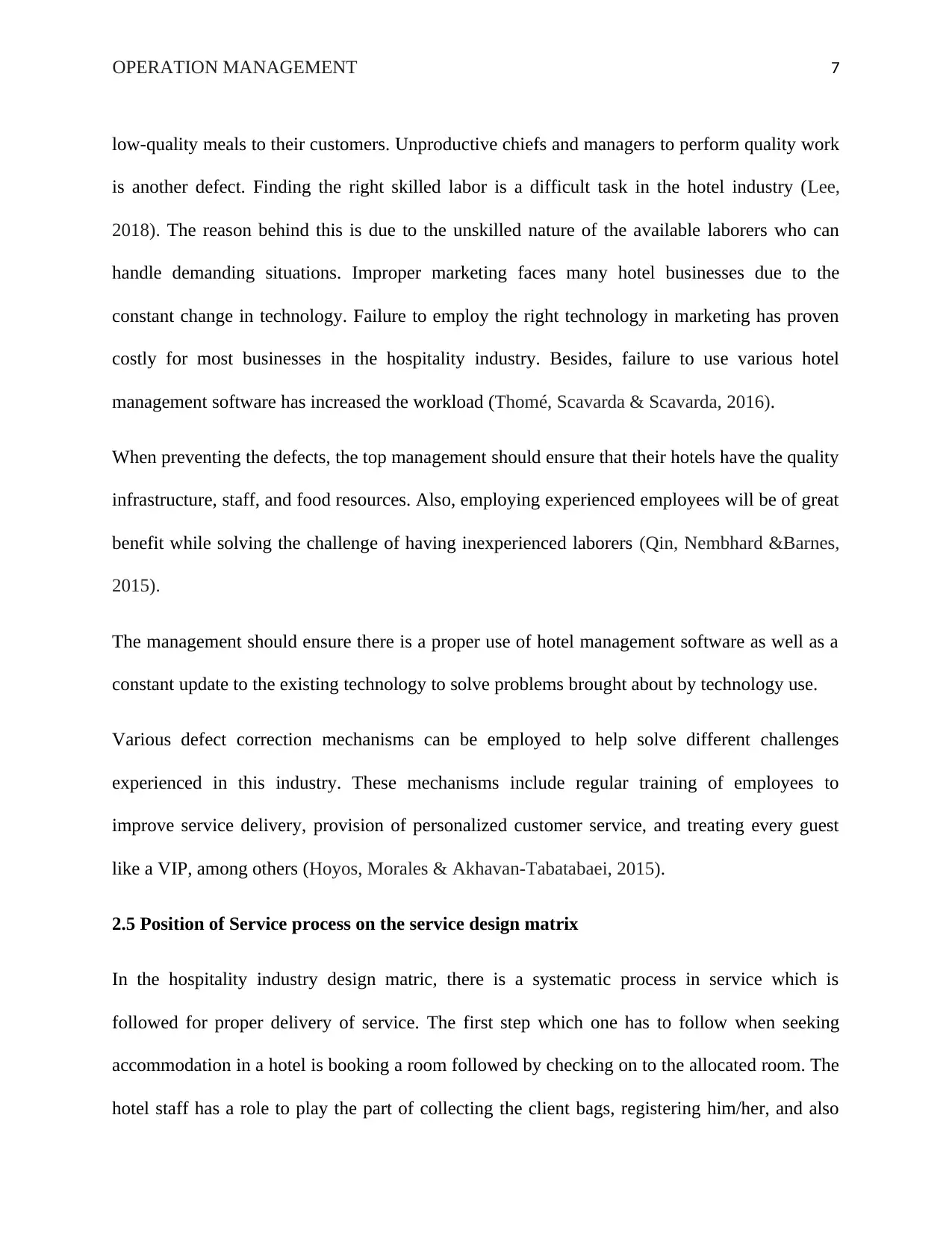
OPERATION MANAGEMENT 7
low-quality meals to their customers. Unproductive chiefs and managers to perform quality work
is another defect. Finding the right skilled labor is a difficult task in the hotel industry (Lee,
2018). The reason behind this is due to the unskilled nature of the available laborers who can
handle demanding situations. Improper marketing faces many hotel businesses due to the
constant change in technology. Failure to employ the right technology in marketing has proven
costly for most businesses in the hospitality industry. Besides, failure to use various hotel
management software has increased the workload (Thomé, Scavarda & Scavarda, 2016).
When preventing the defects, the top management should ensure that their hotels have the quality
infrastructure, staff, and food resources. Also, employing experienced employees will be of great
benefit while solving the challenge of having inexperienced laborers (Qin, Nembhard &Barnes,
2015).
The management should ensure there is a proper use of hotel management software as well as a
constant update to the existing technology to solve problems brought about by technology use.
Various defect correction mechanisms can be employed to help solve different challenges
experienced in this industry. These mechanisms include regular training of employees to
improve service delivery, provision of personalized customer service, and treating every guest
like a VIP, among others (Hoyos, Morales & Akhavan-Tabatabaei, 2015).
2.5 Position of Service process on the service design matrix
In the hospitality industry design matric, there is a systematic process in service which is
followed for proper delivery of service. The first step which one has to follow when seeking
accommodation in a hotel is booking a room followed by checking on to the allocated room. The
hotel staff has a role to play the part of collecting the client bags, registering him/her, and also
low-quality meals to their customers. Unproductive chiefs and managers to perform quality work
is another defect. Finding the right skilled labor is a difficult task in the hotel industry (Lee,
2018). The reason behind this is due to the unskilled nature of the available laborers who can
handle demanding situations. Improper marketing faces many hotel businesses due to the
constant change in technology. Failure to employ the right technology in marketing has proven
costly for most businesses in the hospitality industry. Besides, failure to use various hotel
management software has increased the workload (Thomé, Scavarda & Scavarda, 2016).
When preventing the defects, the top management should ensure that their hotels have the quality
infrastructure, staff, and food resources. Also, employing experienced employees will be of great
benefit while solving the challenge of having inexperienced laborers (Qin, Nembhard &Barnes,
2015).
The management should ensure there is a proper use of hotel management software as well as a
constant update to the existing technology to solve problems brought about by technology use.
Various defect correction mechanisms can be employed to help solve different challenges
experienced in this industry. These mechanisms include regular training of employees to
improve service delivery, provision of personalized customer service, and treating every guest
like a VIP, among others (Hoyos, Morales & Akhavan-Tabatabaei, 2015).
2.5 Position of Service process on the service design matrix
In the hospitality industry design matric, there is a systematic process in service which is
followed for proper delivery of service. The first step which one has to follow when seeking
accommodation in a hotel is booking a room followed by checking on to the allocated room. The
hotel staff has a role to play the part of collecting the client bags, registering him/her, and also
Paraphrase This Document
Need a fresh take? Get an instant paraphrase of this document with our AI Paraphraser
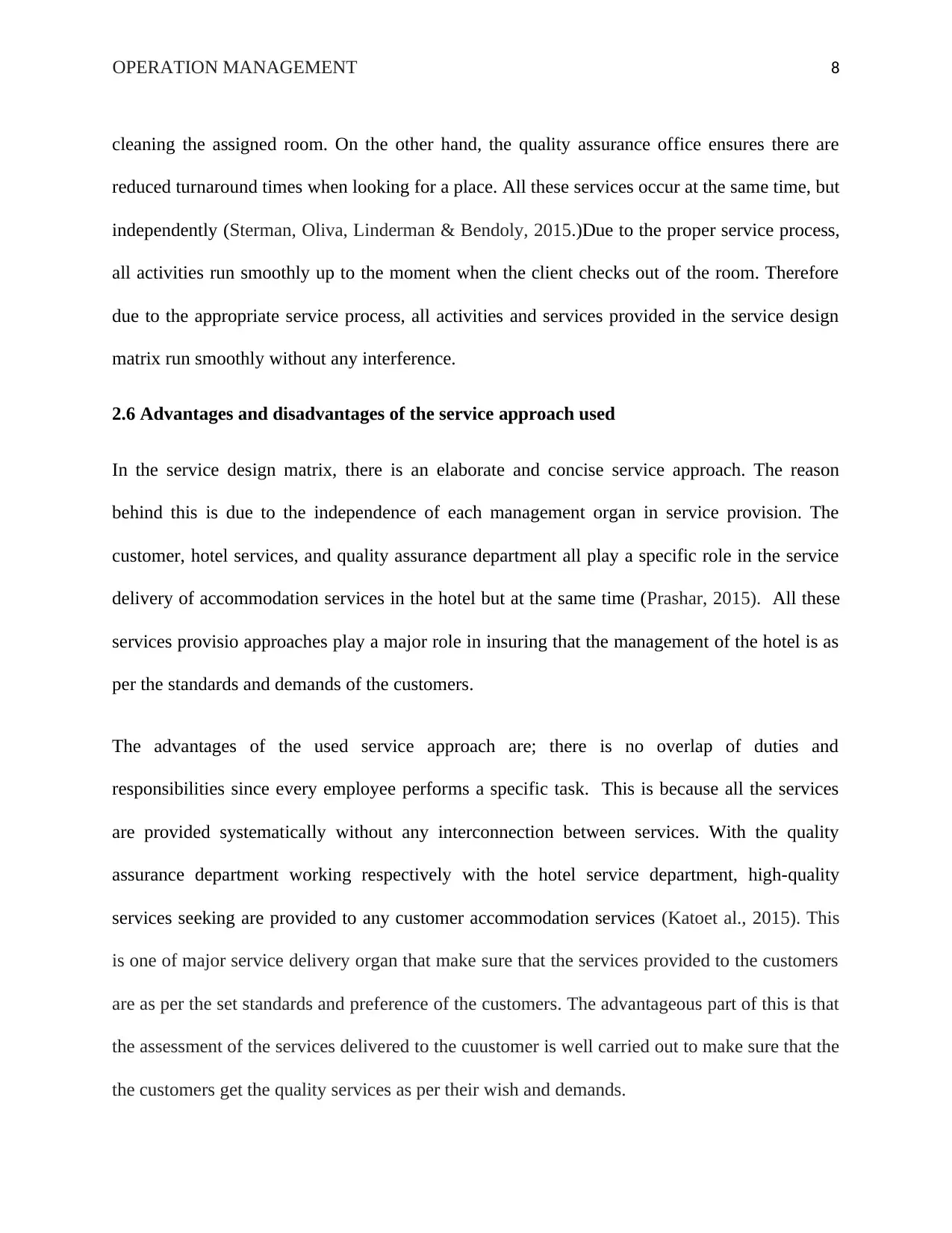
OPERATION MANAGEMENT 8
cleaning the assigned room. On the other hand, the quality assurance office ensures there are
reduced turnaround times when looking for a place. All these services occur at the same time, but
independently (Sterman, Oliva, Linderman & Bendoly, 2015.)Due to the proper service process,
all activities run smoothly up to the moment when the client checks out of the room. Therefore
due to the appropriate service process, all activities and services provided in the service design
matrix run smoothly without any interference.
2.6 Advantages and disadvantages of the service approach used
In the service design matrix, there is an elaborate and concise service approach. The reason
behind this is due to the independence of each management organ in service provision. The
customer, hotel services, and quality assurance department all play a specific role in the service
delivery of accommodation services in the hotel but at the same time (Prashar, 2015). All these
services provisio approaches play a major role in insuring that the management of the hotel is as
per the standards and demands of the customers.
The advantages of the used service approach are; there is no overlap of duties and
responsibilities since every employee performs a specific task. This is because all the services
are provided systematically without any interconnection between services. With the quality
assurance department working respectively with the hotel service department, high-quality
services seeking are provided to any customer accommodation services (Katoet al., 2015). This
is one of major service delivery organ that make sure that the services provided to the customers
are as per the set standards and preference of the customers. The advantageous part of this is that
the assessment of the services delivered to the cuustomer is well carried out to make sure that the
the customers get the quality services as per their wish and demands.
cleaning the assigned room. On the other hand, the quality assurance office ensures there are
reduced turnaround times when looking for a place. All these services occur at the same time, but
independently (Sterman, Oliva, Linderman & Bendoly, 2015.)Due to the proper service process,
all activities run smoothly up to the moment when the client checks out of the room. Therefore
due to the appropriate service process, all activities and services provided in the service design
matrix run smoothly without any interference.
2.6 Advantages and disadvantages of the service approach used
In the service design matrix, there is an elaborate and concise service approach. The reason
behind this is due to the independence of each management organ in service provision. The
customer, hotel services, and quality assurance department all play a specific role in the service
delivery of accommodation services in the hotel but at the same time (Prashar, 2015). All these
services provisio approaches play a major role in insuring that the management of the hotel is as
per the standards and demands of the customers.
The advantages of the used service approach are; there is no overlap of duties and
responsibilities since every employee performs a specific task. This is because all the services
are provided systematically without any interconnection between services. With the quality
assurance department working respectively with the hotel service department, high-quality
services seeking are provided to any customer accommodation services (Katoet al., 2015). This
is one of major service delivery organ that make sure that the services provided to the customers
are as per the set standards and preference of the customers. The advantageous part of this is that
the assessment of the services delivered to the cuustomer is well carried out to make sure that the
the customers get the quality services as per their wish and demands.
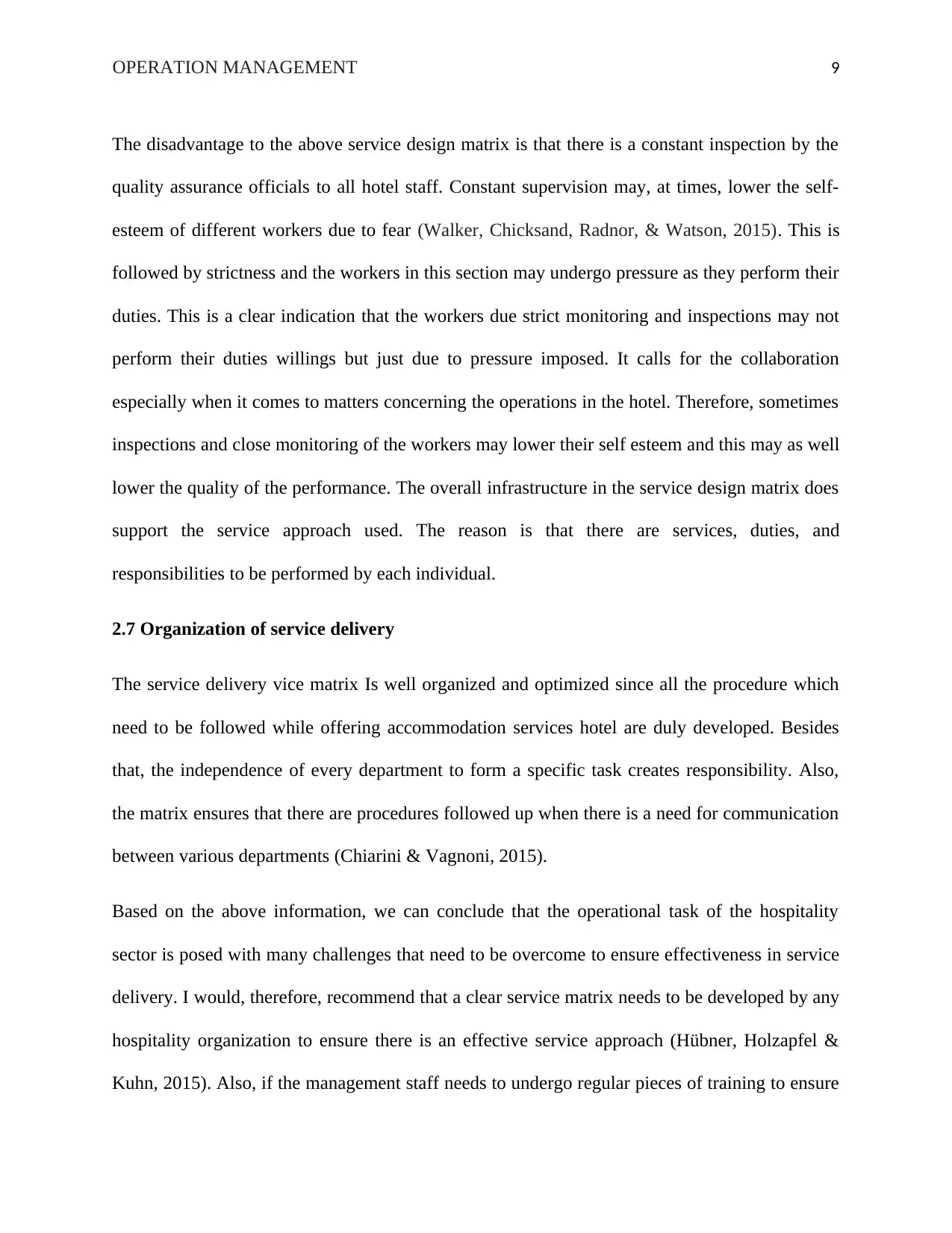
OPERATION MANAGEMENT 9
The disadvantage to the above service design matrix is that there is a constant inspection by the
quality assurance officials to all hotel staff. Constant supervision may, at times, lower the self-
esteem of different workers due to fear (Walker, Chicksand, Radnor, & Watson, 2015). This is
followed by strictness and the workers in this section may undergo pressure as they perform their
duties. This is a clear indication that the workers due strict monitoring and inspections may not
perform their duties willings but just due to pressure imposed. It calls for the collaboration
especially when it comes to matters concerning the operations in the hotel. Therefore, sometimes
inspections and close monitoring of the workers may lower their self esteem and this may as well
lower the quality of the performance. The overall infrastructure in the service design matrix does
support the service approach used. The reason is that there are services, duties, and
responsibilities to be performed by each individual.
2.7 Organization of service delivery
The service delivery vice matrix Is well organized and optimized since all the procedure which
need to be followed while offering accommodation services hotel are duly developed. Besides
that, the independence of every department to form a specific task creates responsibility. Also,
the matrix ensures that there are procedures followed up when there is a need for communication
between various departments (Chiarini & Vagnoni, 2015).
Based on the above information, we can conclude that the operational task of the hospitality
sector is posed with many challenges that need to be overcome to ensure effectiveness in service
delivery. I would, therefore, recommend that a clear service matrix needs to be developed by any
hospitality organization to ensure there is an effective service approach (Hübner, Holzapfel &
Kuhn, 2015). Also, if the management staff needs to undergo regular pieces of training to ensure
The disadvantage to the above service design matrix is that there is a constant inspection by the
quality assurance officials to all hotel staff. Constant supervision may, at times, lower the self-
esteem of different workers due to fear (Walker, Chicksand, Radnor, & Watson, 2015). This is
followed by strictness and the workers in this section may undergo pressure as they perform their
duties. This is a clear indication that the workers due strict monitoring and inspections may not
perform their duties willings but just due to pressure imposed. It calls for the collaboration
especially when it comes to matters concerning the operations in the hotel. Therefore, sometimes
inspections and close monitoring of the workers may lower their self esteem and this may as well
lower the quality of the performance. The overall infrastructure in the service design matrix does
support the service approach used. The reason is that there are services, duties, and
responsibilities to be performed by each individual.
2.7 Organization of service delivery
The service delivery vice matrix Is well organized and optimized since all the procedure which
need to be followed while offering accommodation services hotel are duly developed. Besides
that, the independence of every department to form a specific task creates responsibility. Also,
the matrix ensures that there are procedures followed up when there is a need for communication
between various departments (Chiarini & Vagnoni, 2015).
Based on the above information, we can conclude that the operational task of the hospitality
sector is posed with many challenges that need to be overcome to ensure effectiveness in service
delivery. I would, therefore, recommend that a clear service matrix needs to be developed by any
hospitality organization to ensure there is an effective service approach (Hübner, Holzapfel &
Kuhn, 2015). Also, if the management staff needs to undergo regular pieces of training to ensure
⊘ This is a preview!⊘
Do you want full access?
Subscribe today to unlock all pages.

Trusted by 1+ million students worldwide
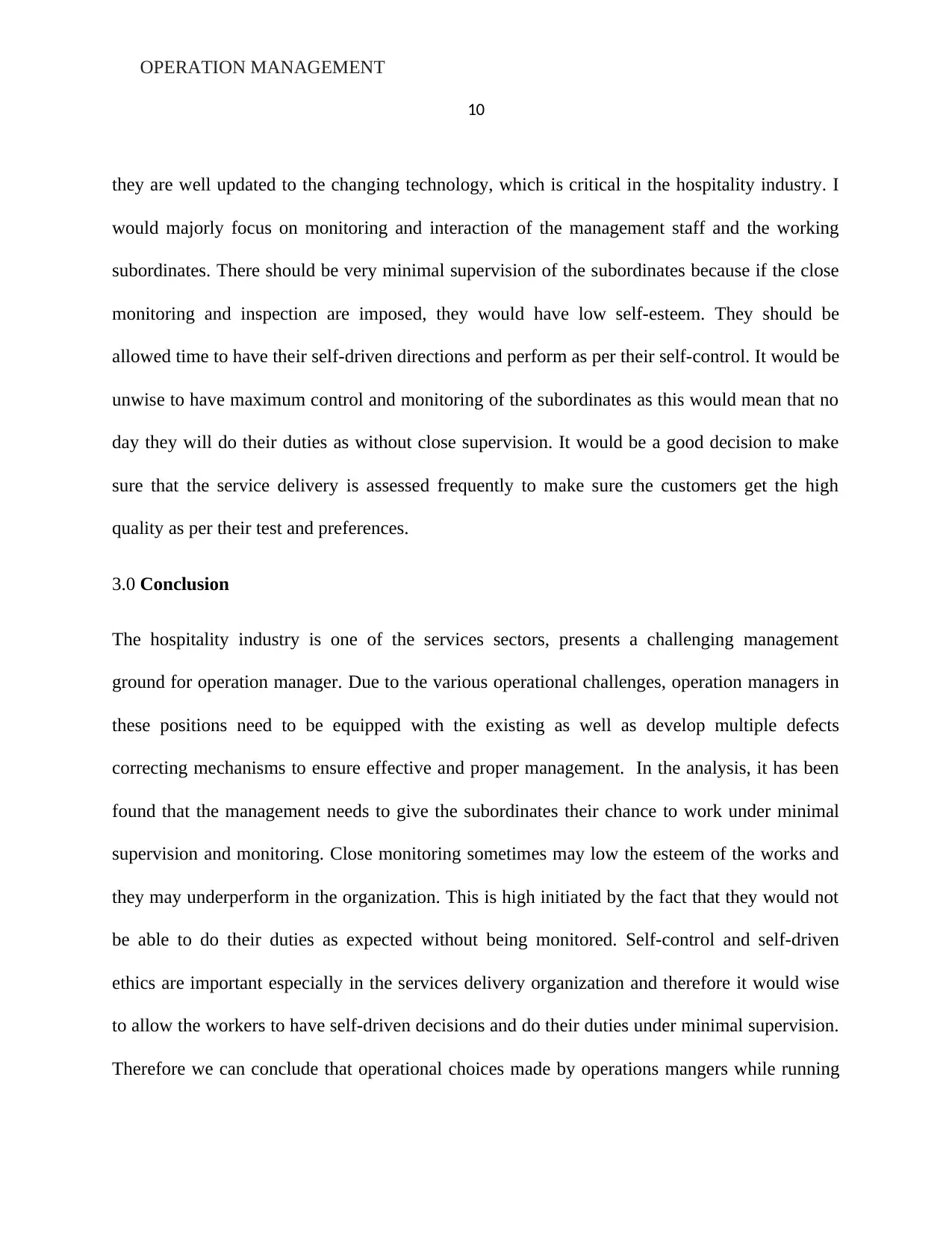
OPERATION MANAGEMENT
10
they are well updated to the changing technology, which is critical in the hospitality industry. I
would majorly focus on monitoring and interaction of the management staff and the working
subordinates. There should be very minimal supervision of the subordinates because if the close
monitoring and inspection are imposed, they would have low self-esteem. They should be
allowed time to have their self-driven directions and perform as per their self-control. It would be
unwise to have maximum control and monitoring of the subordinates as this would mean that no
day they will do their duties as without close supervision. It would be a good decision to make
sure that the service delivery is assessed frequently to make sure the customers get the high
quality as per their test and preferences.
3.0 Conclusion
The hospitality industry is one of the services sectors, presents a challenging management
ground for operation manager. Due to the various operational challenges, operation managers in
these positions need to be equipped with the existing as well as develop multiple defects
correcting mechanisms to ensure effective and proper management. In the analysis, it has been
found that the management needs to give the subordinates their chance to work under minimal
supervision and monitoring. Close monitoring sometimes may low the esteem of the works and
they may underperform in the organization. This is high initiated by the fact that they would not
be able to do their duties as expected without being monitored. Self-control and self-driven
ethics are important especially in the services delivery organization and therefore it would wise
to allow the workers to have self-driven decisions and do their duties under minimal supervision.
Therefore we can conclude that operational choices made by operations mangers while running
10
they are well updated to the changing technology, which is critical in the hospitality industry. I
would majorly focus on monitoring and interaction of the management staff and the working
subordinates. There should be very minimal supervision of the subordinates because if the close
monitoring and inspection are imposed, they would have low self-esteem. They should be
allowed time to have their self-driven directions and perform as per their self-control. It would be
unwise to have maximum control and monitoring of the subordinates as this would mean that no
day they will do their duties as without close supervision. It would be a good decision to make
sure that the service delivery is assessed frequently to make sure the customers get the high
quality as per their test and preferences.
3.0 Conclusion
The hospitality industry is one of the services sectors, presents a challenging management
ground for operation manager. Due to the various operational challenges, operation managers in
these positions need to be equipped with the existing as well as develop multiple defects
correcting mechanisms to ensure effective and proper management. In the analysis, it has been
found that the management needs to give the subordinates their chance to work under minimal
supervision and monitoring. Close monitoring sometimes may low the esteem of the works and
they may underperform in the organization. This is high initiated by the fact that they would not
be able to do their duties as expected without being monitored. Self-control and self-driven
ethics are important especially in the services delivery organization and therefore it would wise
to allow the workers to have self-driven decisions and do their duties under minimal supervision.
Therefore we can conclude that operational choices made by operations mangers while running
Paraphrase This Document
Need a fresh take? Get an instant paraphrase of this document with our AI Paraphraser
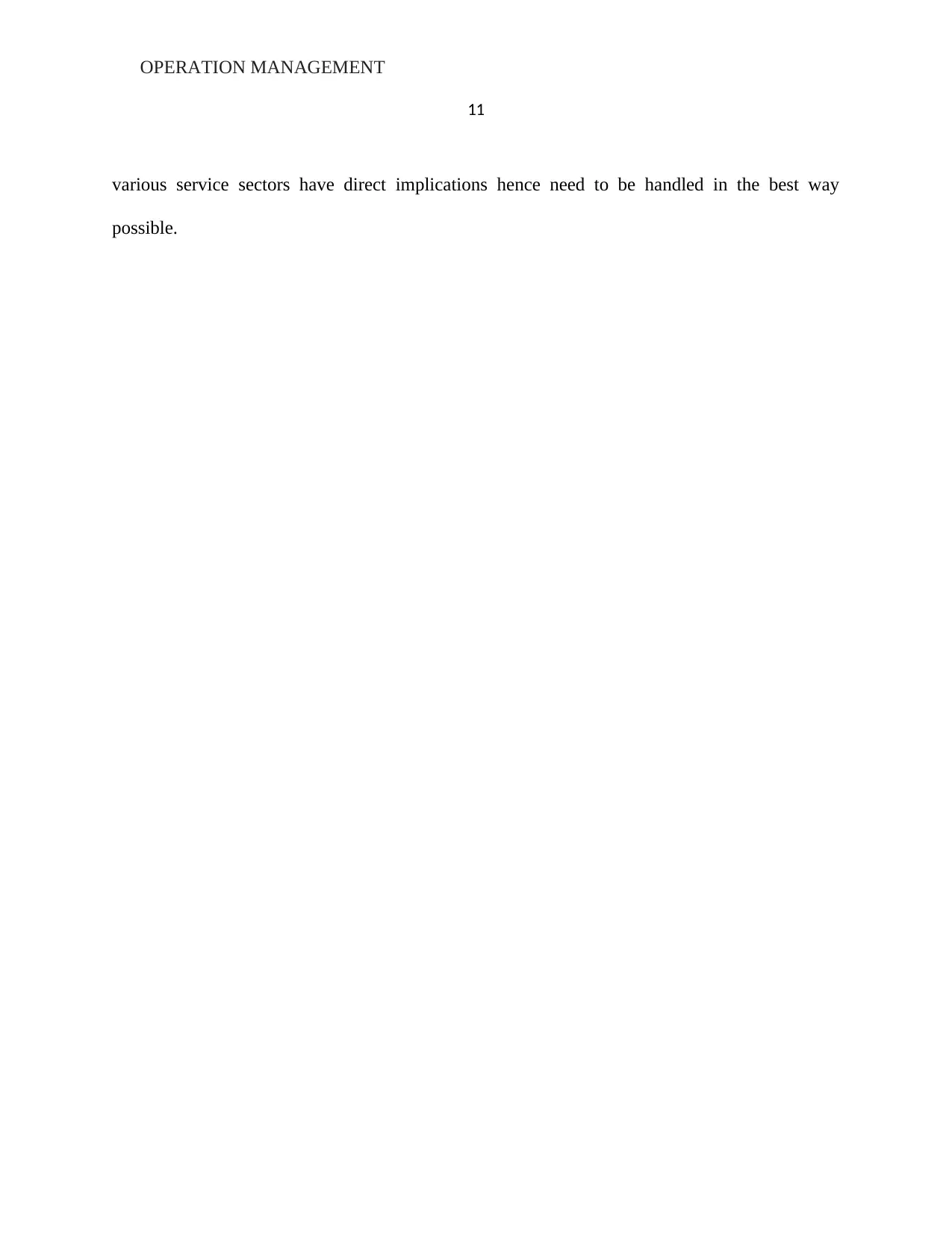
OPERATION MANAGEMENT
11
various service sectors have direct implications hence need to be handled in the best way
possible.
11
various service sectors have direct implications hence need to be handled in the best way
possible.
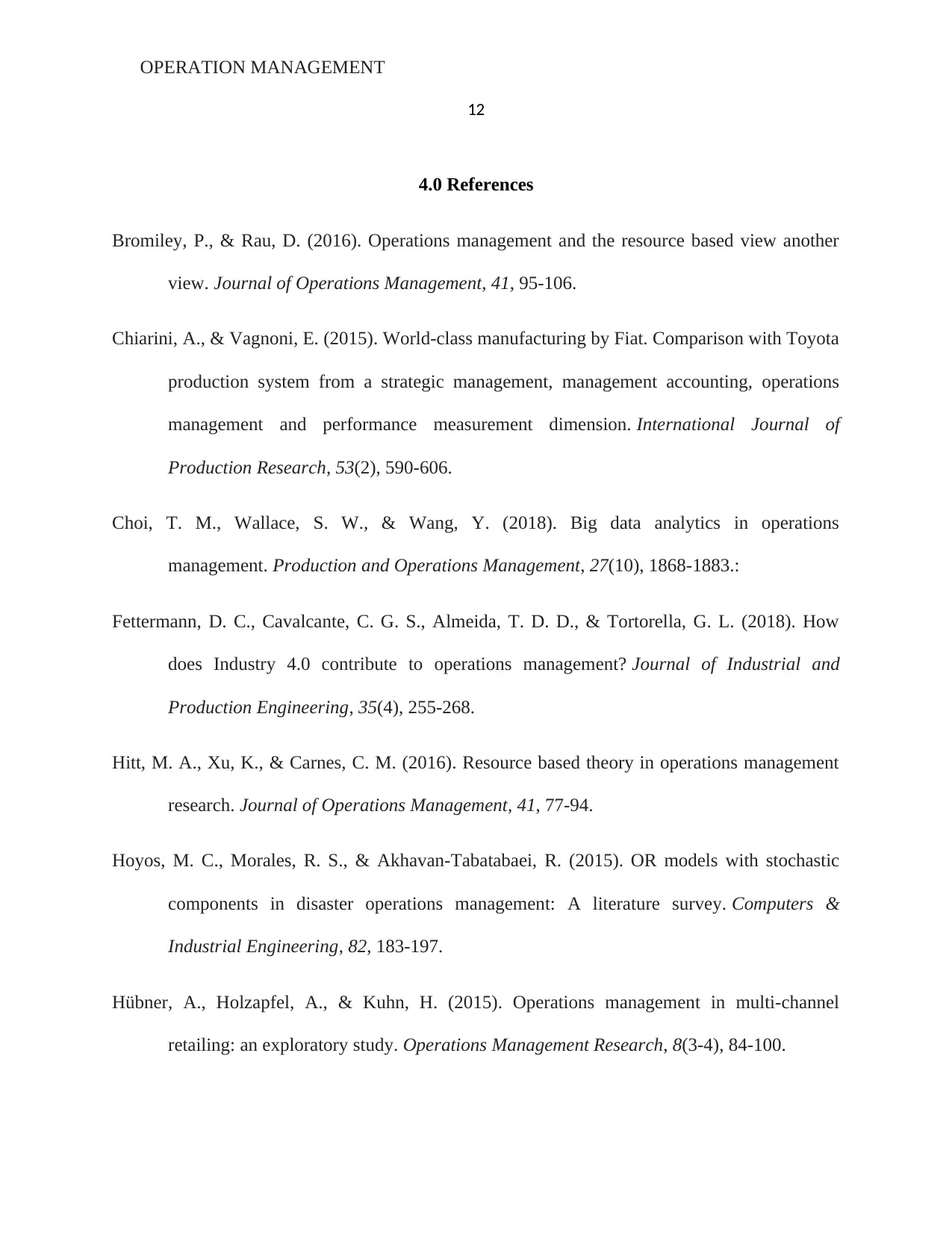
OPERATION MANAGEMENT
12
4.0 References
Bromiley, P., & Rau, D. (2016). Operations management and the resource based view another
view. Journal of Operations Management, 41, 95-106.
Chiarini, A., & Vagnoni, E. (2015). World-class manufacturing by Fiat. Comparison with Toyota
production system from a strategic management, management accounting, operations
management and performance measurement dimension. International Journal of
Production Research, 53(2), 590-606.
Choi, T. M., Wallace, S. W., & Wang, Y. (2018). Big data analytics in operations
management. Production and Operations Management, 27(10), 1868-1883.:
Fettermann, D. C., Cavalcante, C. G. S., Almeida, T. D. D., & Tortorella, G. L. (2018). How
does Industry 4.0 contribute to operations management? Journal of Industrial and
Production Engineering, 35(4), 255-268.
Hitt, M. A., Xu, K., & Carnes, C. M. (2016). Resource based theory in operations management
research. Journal of Operations Management, 41, 77-94.
Hoyos, M. C., Morales, R. S., & Akhavan-Tabatabaei, R. (2015). OR models with stochastic
components in disaster operations management: A literature survey. Computers &
Industrial Engineering, 82, 183-197.
Hübner, A., Holzapfel, A., & Kuhn, H. (2015). Operations management in multi-channel
retailing: an exploratory study. Operations Management Research, 8(3-4), 84-100.
12
4.0 References
Bromiley, P., & Rau, D. (2016). Operations management and the resource based view another
view. Journal of Operations Management, 41, 95-106.
Chiarini, A., & Vagnoni, E. (2015). World-class manufacturing by Fiat. Comparison with Toyota
production system from a strategic management, management accounting, operations
management and performance measurement dimension. International Journal of
Production Research, 53(2), 590-606.
Choi, T. M., Wallace, S. W., & Wang, Y. (2018). Big data analytics in operations
management. Production and Operations Management, 27(10), 1868-1883.:
Fettermann, D. C., Cavalcante, C. G. S., Almeida, T. D. D., & Tortorella, G. L. (2018). How
does Industry 4.0 contribute to operations management? Journal of Industrial and
Production Engineering, 35(4), 255-268.
Hitt, M. A., Xu, K., & Carnes, C. M. (2016). Resource based theory in operations management
research. Journal of Operations Management, 41, 77-94.
Hoyos, M. C., Morales, R. S., & Akhavan-Tabatabaei, R. (2015). OR models with stochastic
components in disaster operations management: A literature survey. Computers &
Industrial Engineering, 82, 183-197.
Hübner, A., Holzapfel, A., & Kuhn, H. (2015). Operations management in multi-channel
retailing: an exploratory study. Operations Management Research, 8(3-4), 84-100.
⊘ This is a preview!⊘
Do you want full access?
Subscribe today to unlock all pages.

Trusted by 1+ million students worldwide
1 out of 14
Related Documents
Your All-in-One AI-Powered Toolkit for Academic Success.
+13062052269
info@desklib.com
Available 24*7 on WhatsApp / Email
![[object Object]](/_next/static/media/star-bottom.7253800d.svg)
Unlock your academic potential
Copyright © 2020–2025 A2Z Services. All Rights Reserved. Developed and managed by ZUCOL.




